The AMD Llano Notebook Review: Competing in the Mobile Market
by Jarred Walton & Anand Lal Shimpi on June 14, 2011 12:01 AM ESTPower Gating
With 1.45 billion transistors on die, Llano relies on extensive power gating in order to keep things in order. The APU is split into two independent power islands: the CPU and the GPU. The memory controller and North Bridge both live on the GPU's power island. Each island has its own independent voltage source.
Everything from an individual CPU core to the entire GPU or virtually the entire APU package can be power gated. AMD provided photon recombination images to show the impact power gating the GPU can have on leakage current:
Although not depicted above, Llano can also fully power gate the x86 CPU cores or both the CPU and GPU if the entire APU is in a deep sleep state. Being able to completely power gate CPU cores or the GPU is an important part of enabling the next major feature of Llano: Turbo Core.
Turbo Core
All processors whether CPUs, GPUs or APUs have to be designed to strict thermal and power limits. OEMs need to know exactly what sort of chassis they'll be able to build around these chips and as a result the chip vendors provide guidance in the form of specifications, including the chip's thermal design point (TDP).
In the old days of microprocessors things were simple. You had a single core that ran all the time and it consumed all of the available thermal budget allocated for that core. AMD and Intel eventually enabled dynamic clock frequencies which let your single core underclock itself when it wasn't being used, which helped reduce power and extend battery life. Then came the multi-core era.
CPUs couldn't just start putting out twice as much heat now that they had two cores; instead, each core had to consume less power. The chip guys achieved this by running the cores at lower frequencies and voltages than they did in the single-core days. Two cores paved the way to four cores, which meant another reduction in clock speed per core. Sure we got much better multi-threaded performance, but for single-threaded applications performance wasn't as great as it could be. Users had to make a tradeoff: good multi-threaded performance or good single-threaded performance; you couldn't have both. Until power gating came along that is.
Without power gating you can never really shut off power to an idle core. The transistors aren't switching but power is still dissipated thanks to leakage current. Remember that transistors don't simply stop conducting electricity when they're off. The smaller they get, the more leaky our beloved transistors become. Power gating lets you physically block the flow of current to the transistors that are being gated, so when they're off, they're actually off. With an idle core shut off, now you have the extra TDP headroom to run any active cores at higher frequencies.
Intel does this with a technology it calls Turbo Boost. Intel looks at current draw and thermal sensors spread out all over the chip and determines when it has the available thermal headroom to turbo up any active cores. AMD implements a similar technology in Llano (and previously in their hex-core desktop parts) called Turbo Core.
I say similar but not identical because AMD's approach differs in a very important way. While Intel looks at current draw and temperature data, AMD looks at workload. Each activity within the Llano APU is assigned a certain power weight (e.g. an integer multiply is known to require a certain amount of power). Llano is aware of the operations it's currently working on and based on the weights associated with these operations it comes up with a general estimate of its power consumption on a per core basis. I mention this is an estimate because it correlates digital activity to power consumption; it doesn't actually measure power consumption.
Based on the number of events and their individual weights, AMD estimates the power consumption of each core and determines how much TDP headroom exists in the system. If the OS is requesting the highest p-state from the CPU and there's available TDP headroom, Llano will turbo up any active cores up to a maximum frequency. Like Sandy Bridge, Llano is able to temporarily exceed the APU's maximum TDP if it determines that the recent history of power consumption has been low enough that it'll take a while for the APU to ramp up to any thermal limits.
One major limit of Llano's Turbo Core is that the GPU can't turbo up in the event of the CPU cores being idle. Only the CPU cores can turbo up if they have available headroom. I suspect future versions of Llano will probably enable GPU Turbo Core as well:
It's unclear to me at this point what shortcomings or advantages exist for AMD's Turbo Core method vs. Intel's Turbo Boost. At the bare minimum the two are finally comparable although they use different approaches to attain a similar end result. AMD doesn't yet have a method of actually displaying Turbo Core frequencies, unfortunately, so we're operating a bit blind at this point. Over time I hope to have a better idea of how AMD's solution stacks up.


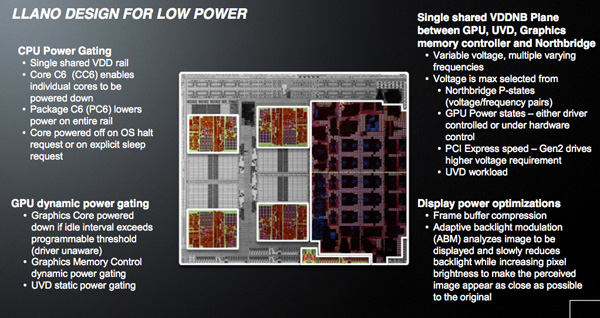
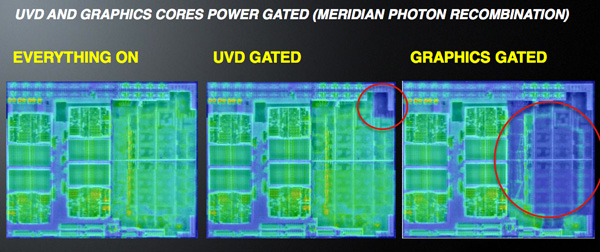
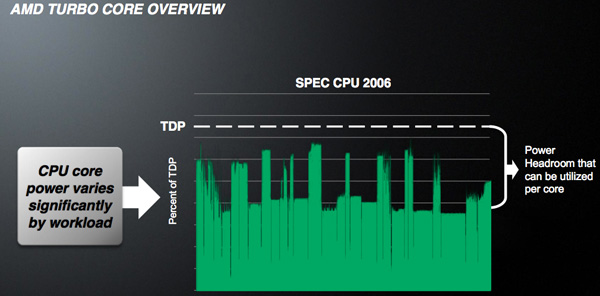
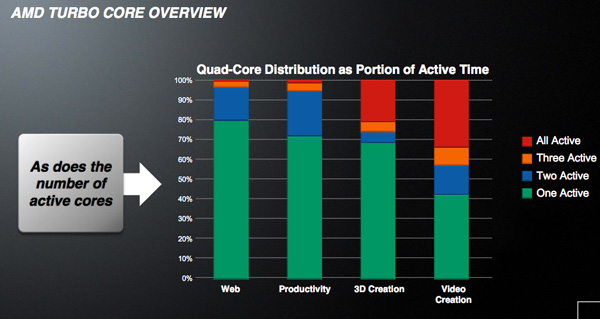
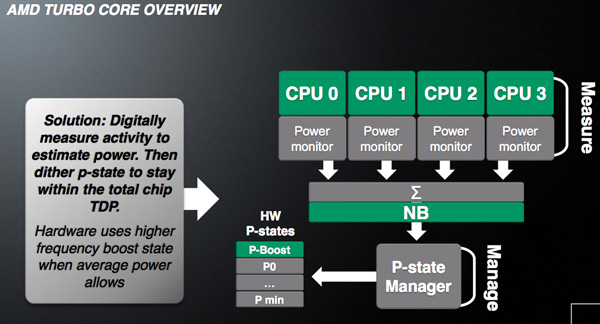
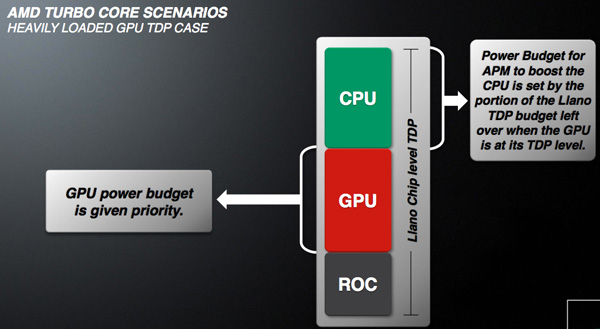
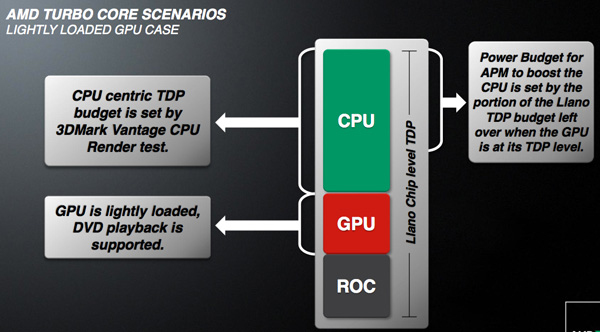








177 Comments
View All Comments
duploxxx - Sunday, June 19, 2011 - link
talking about crap??? men you are good at that, as if you need a 2600K for some compiling and add a 6990 to an e-350.men you do know someting about computers :) your a joke
BushLin - Wednesday, June 22, 2011 - link
If you're going to accuse someone of talking crap (correctly or otherwise) it helps if you know the difference between you're and your when attempting to insult them.Broheim - Monday, June 27, 2011 - link
I use a fast CPU for compiling because I actually like being productive rather than just staring at the screen.my point about the 6990 was that a faster GPU != a better user experience for the vast majority of users, but logic seems to be lost on you.
Regenweald - Tuesday, June 14, 2011 - link
I'm currently playing the Witcher extended with a 2Ghz X2 ,a 4670 and 800 Mhz memory on a desktop with no complaints. In game settings medium and high. Are you saying that 2 more tweaked 32nm cores, 80 more shaders and ddr3 1600 or 1800 memory will not offer a good mobile gaming experience ? please.jollyjugg - Wednesday, June 15, 2011 - link
What kind of super computing application are you going to do in your laptop that you would need that "tremendous CPU power" that you are talking about. As somebody who has used both intel and amd machines for years I can tell you that for most user applications, you will hardly notice any difference in performance. The main complaint was that AMD machines were running hot particularly after intel cameup with power gating in nehalem in 2008. With this part you get a machine that runs way way cooler and almost 150- 200 bucks cheaper than comparable intel machines plus you get discrete quality graphics for free. Nobody can change cynics like you. Because you cant expect Intel to sell anything cheap you would want to AMD to sell things cheaper. Well if you want good things in life you should be prepared to pay. Dont write trash. Like gaming is not important for average user, tremendous computing power and 3 GHz CPU speed is also not important for the average PC user. But multimedia and movie rendering etc is. So go Llano!!!Seikent - Tuesday, June 14, 2011 - link
This platform offer some good things, but if the prices aren't low it won't go well. Now it's quite easy to find a sandy bridge notebook with discrete gpu for a few more dollars.If ACF does achieve to work like CF in the future, it would be great!
SteelCity1981 - Tuesday, June 14, 2011 - link
Finally we have an intergrated graphics solution that's worth really talking about.aegisofrime - Tuesday, June 14, 2011 - link
Judging by the performance, this part won't be priced very high. And that's a worry, considering that it packs 1.45 billion transistors. In comparison, Sandy Bridge is 995 million transistors, and sells for more money. Profit margins are gonna be tight on this one.JarredWalton - Tuesday, June 14, 2011 - link
AMD has a slide that points out that compared to their previous generation, they're packing a 66 mm2 Northbridge, 200 mm2 CPU, and 1080 mm2 dGPU into a 228 mm2 package. They've made money this past quarter, so this should do better than Athlon/Phenom II.JarredWalton - Tuesday, June 14, 2011 - link
Note: that's supposed to be 108 mm2 GPU, not 1080. Whoops.